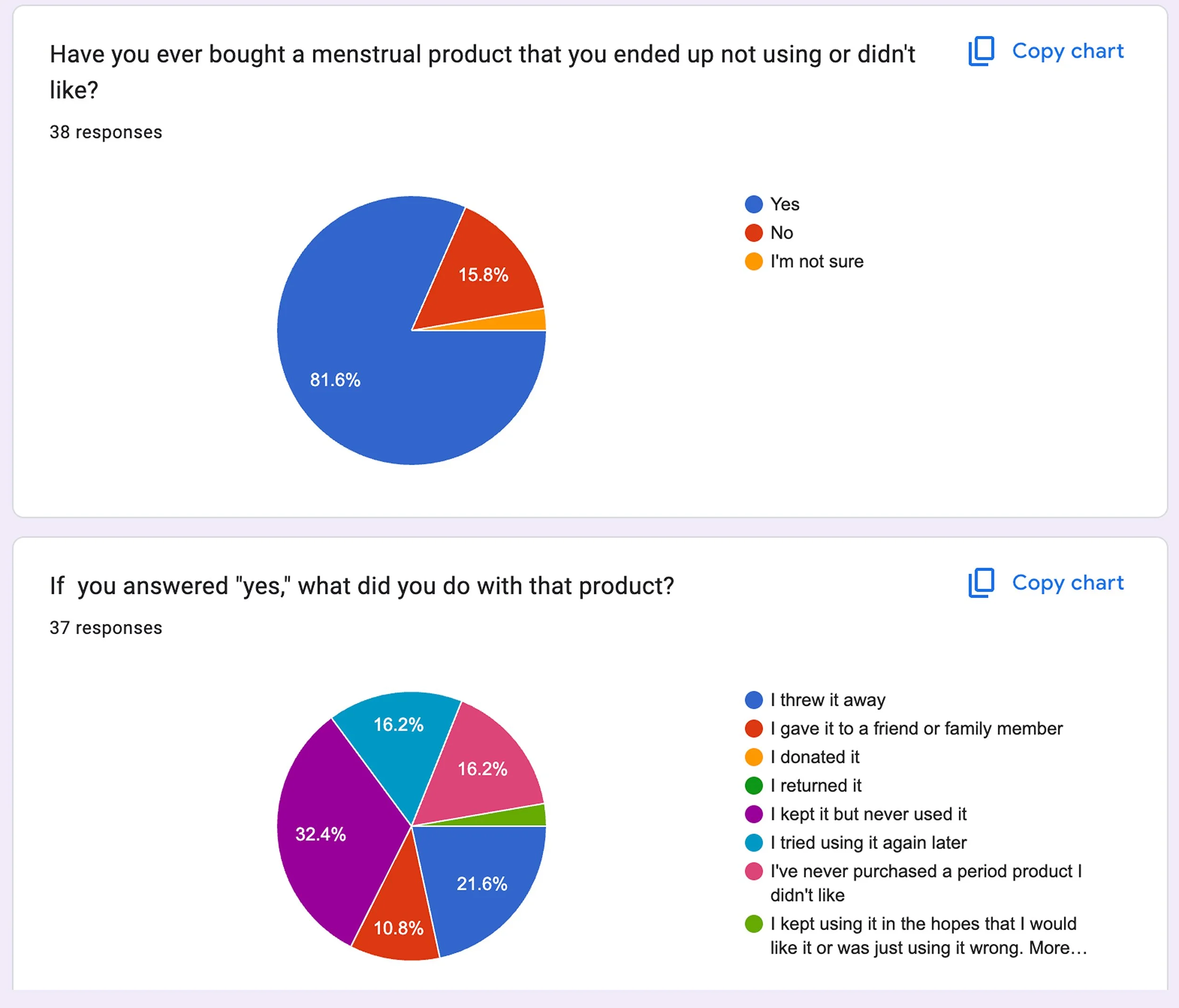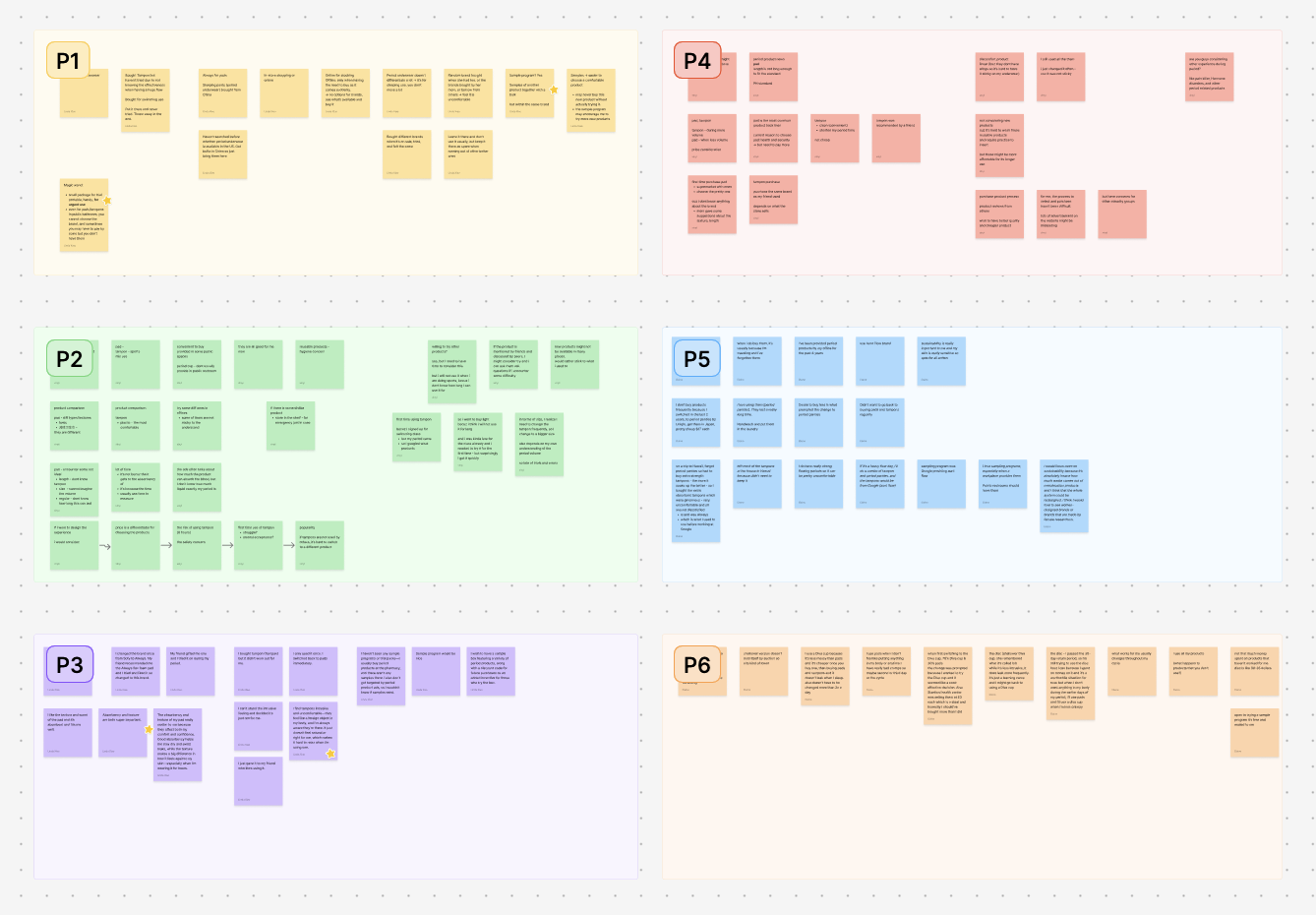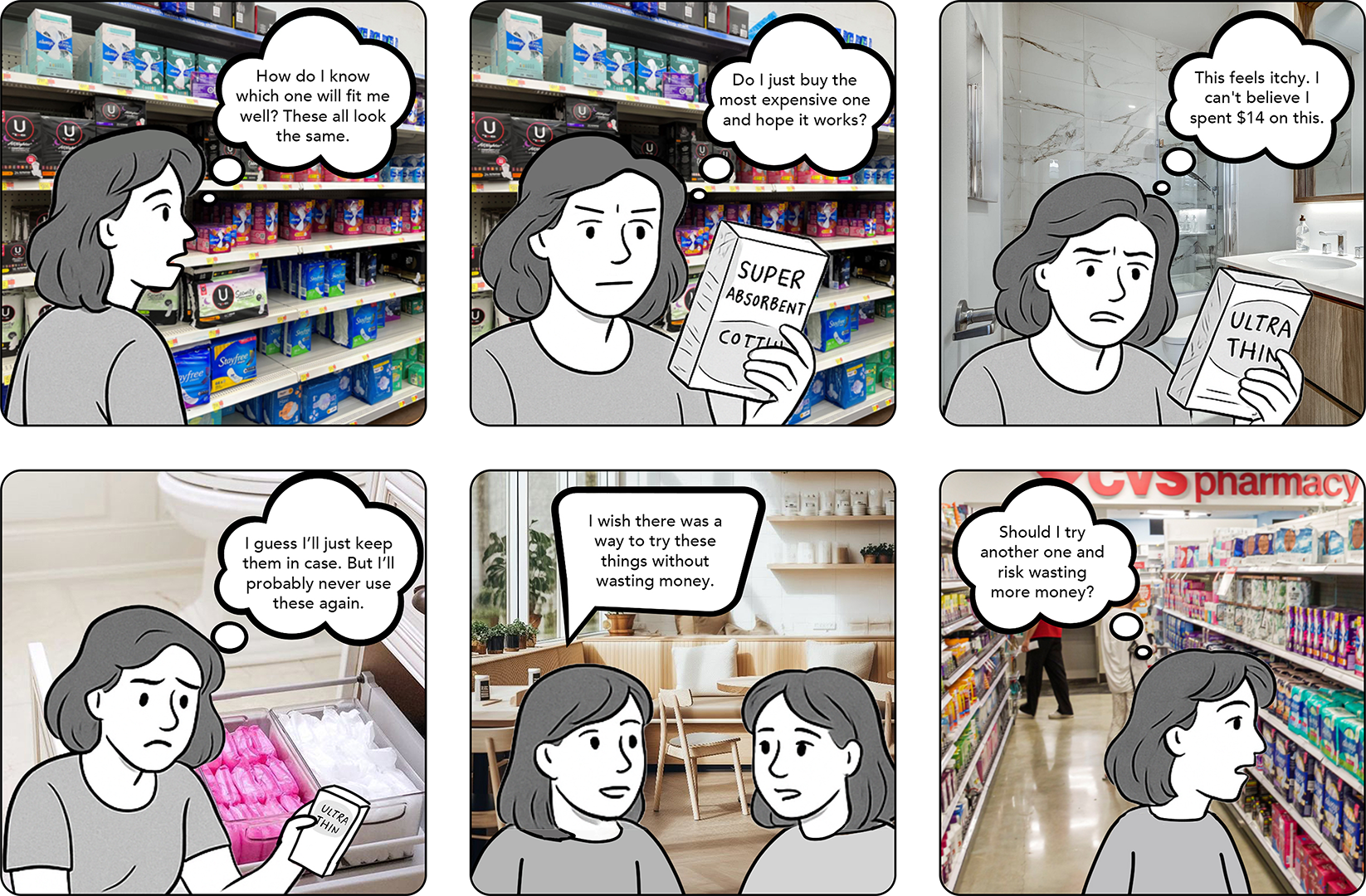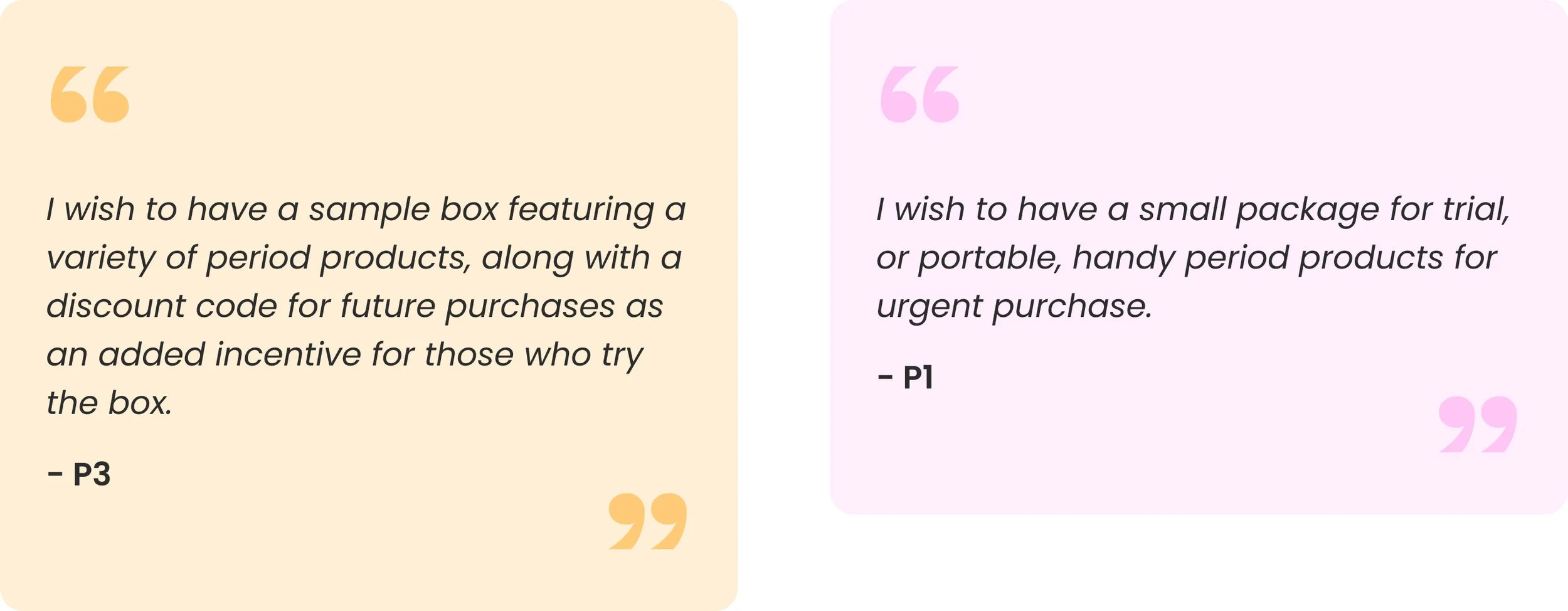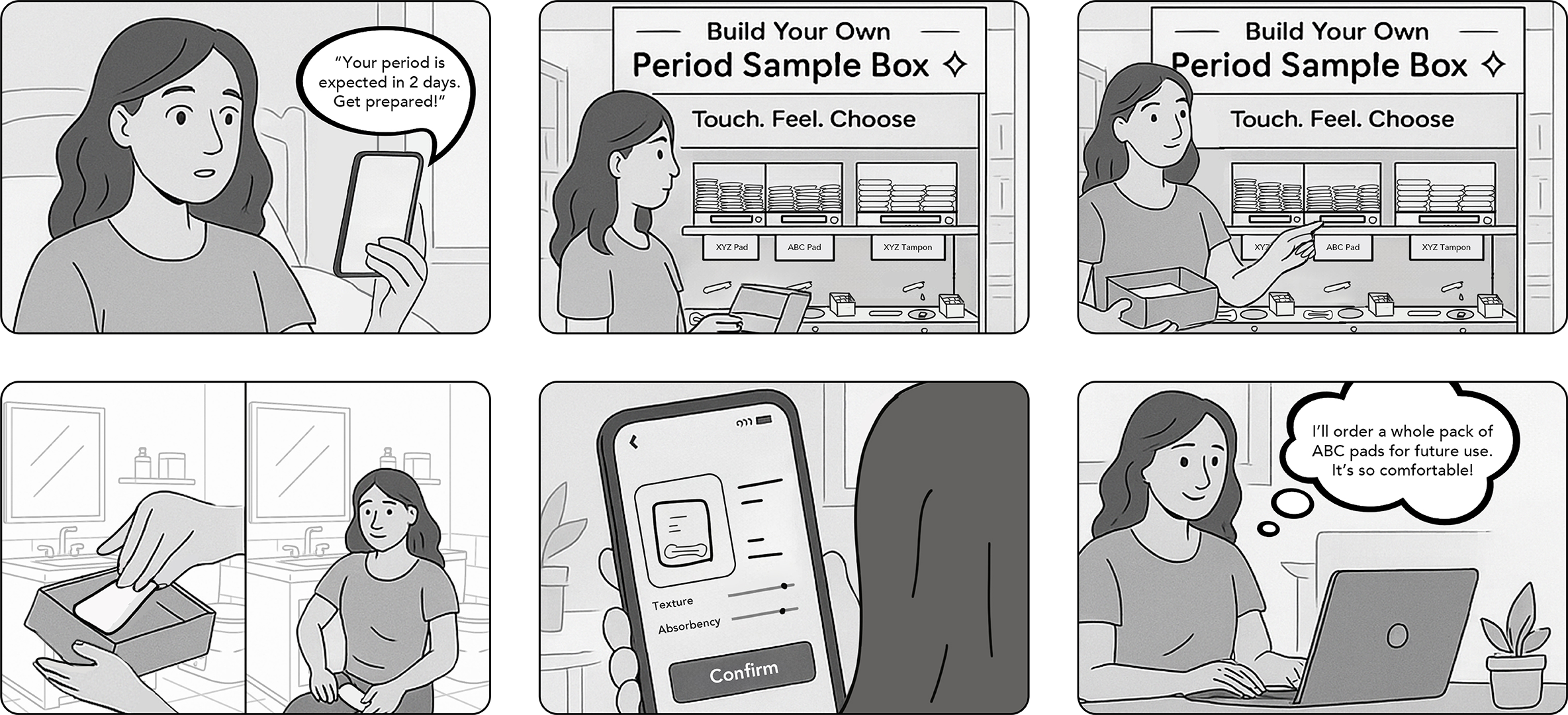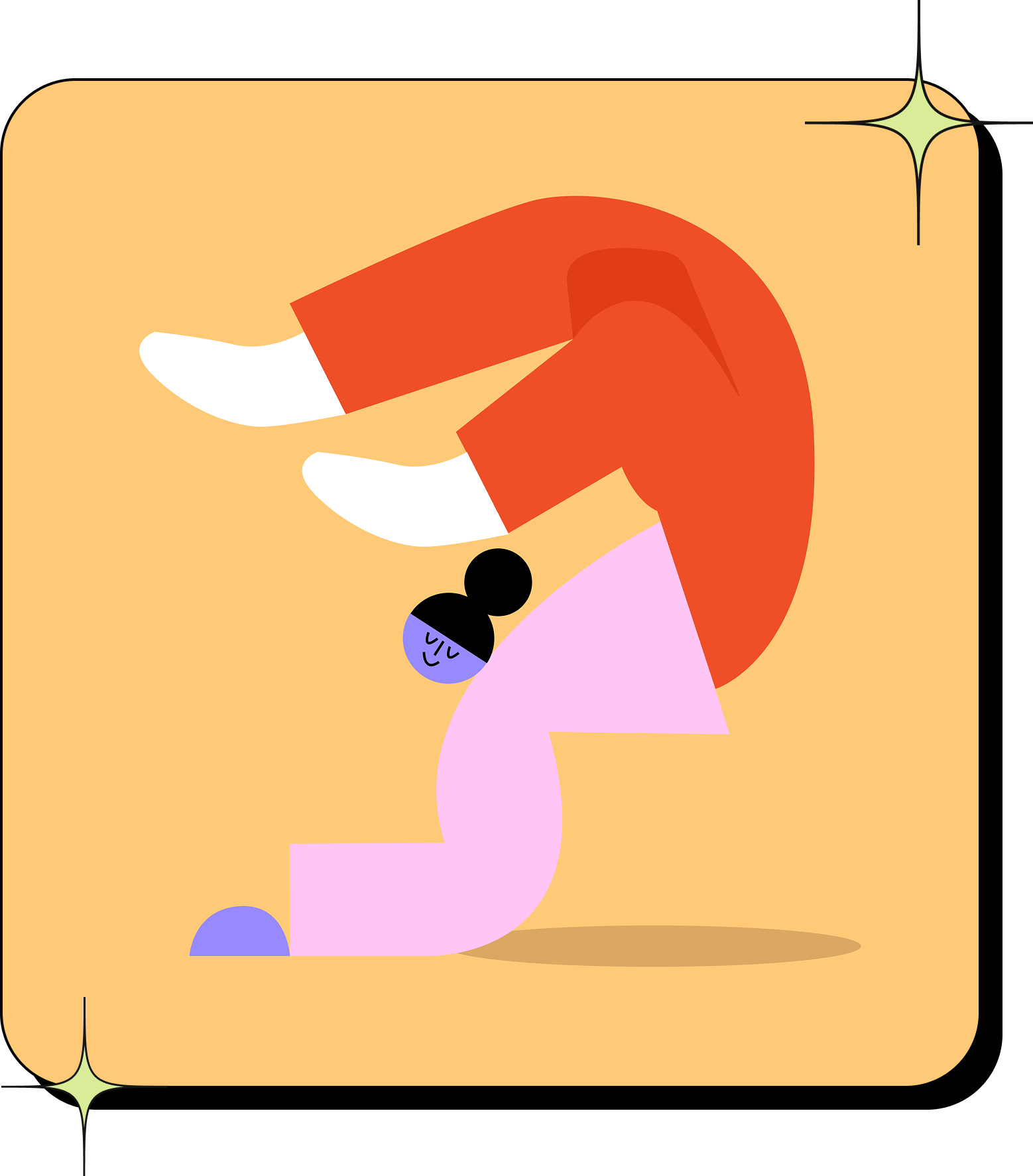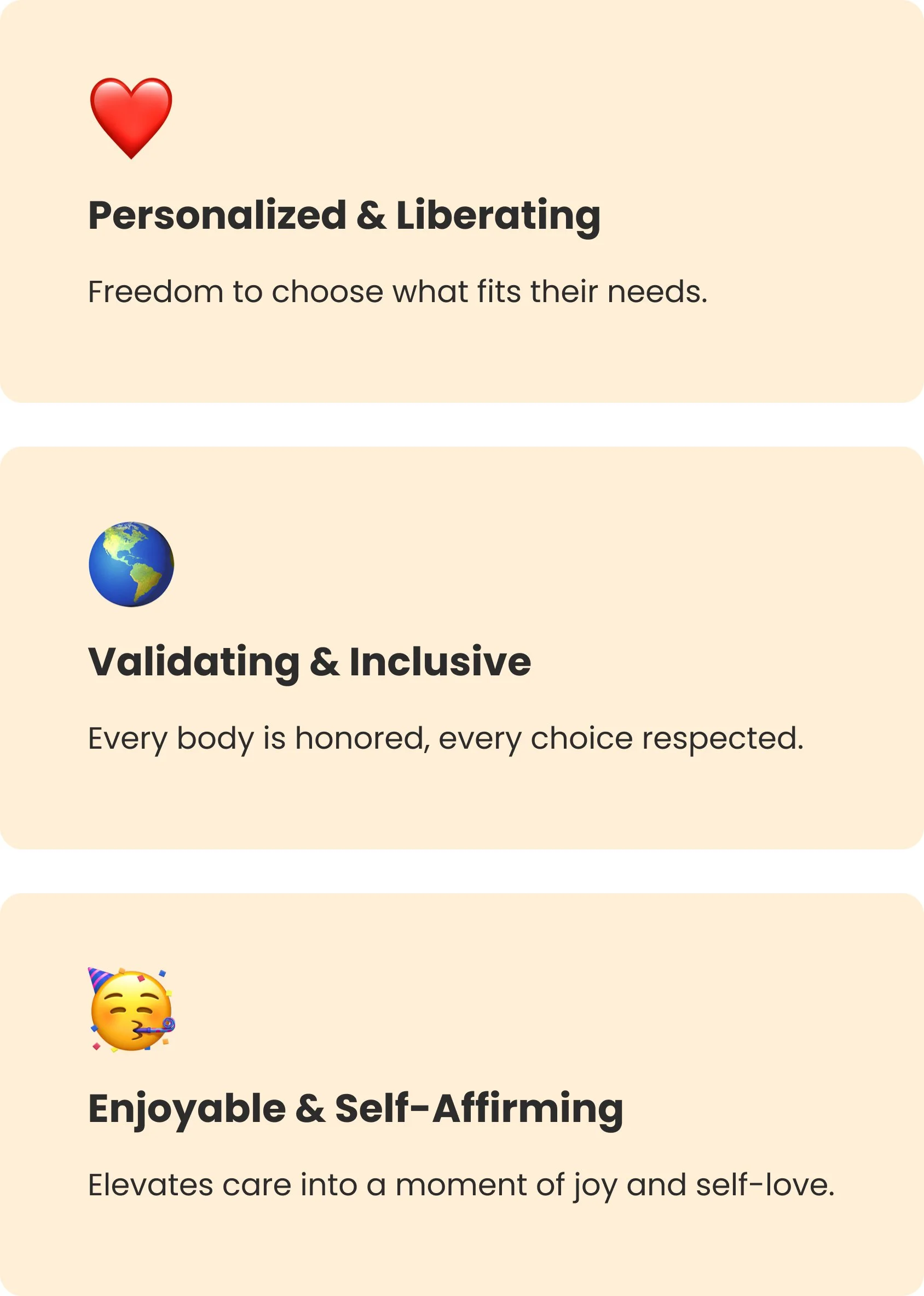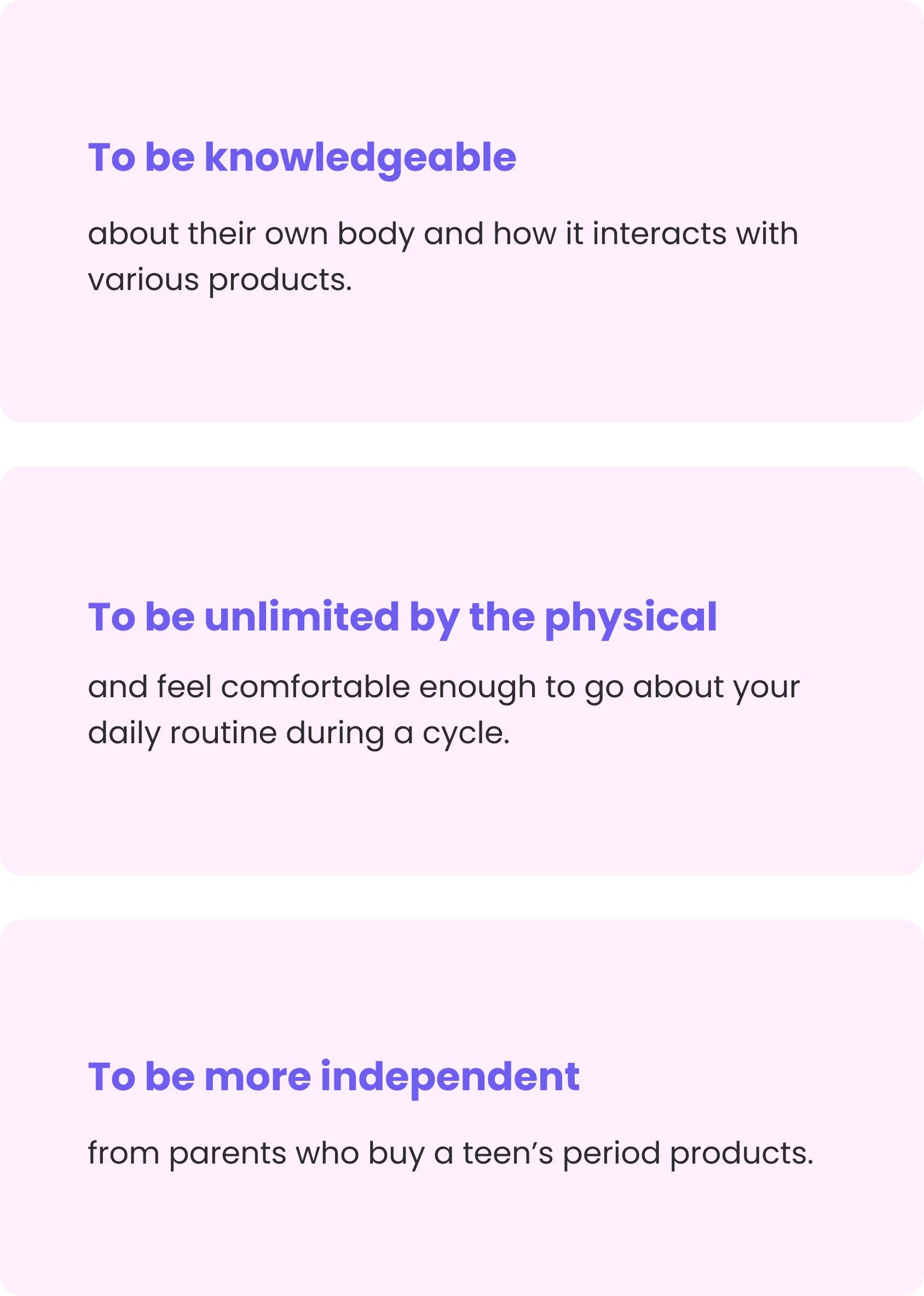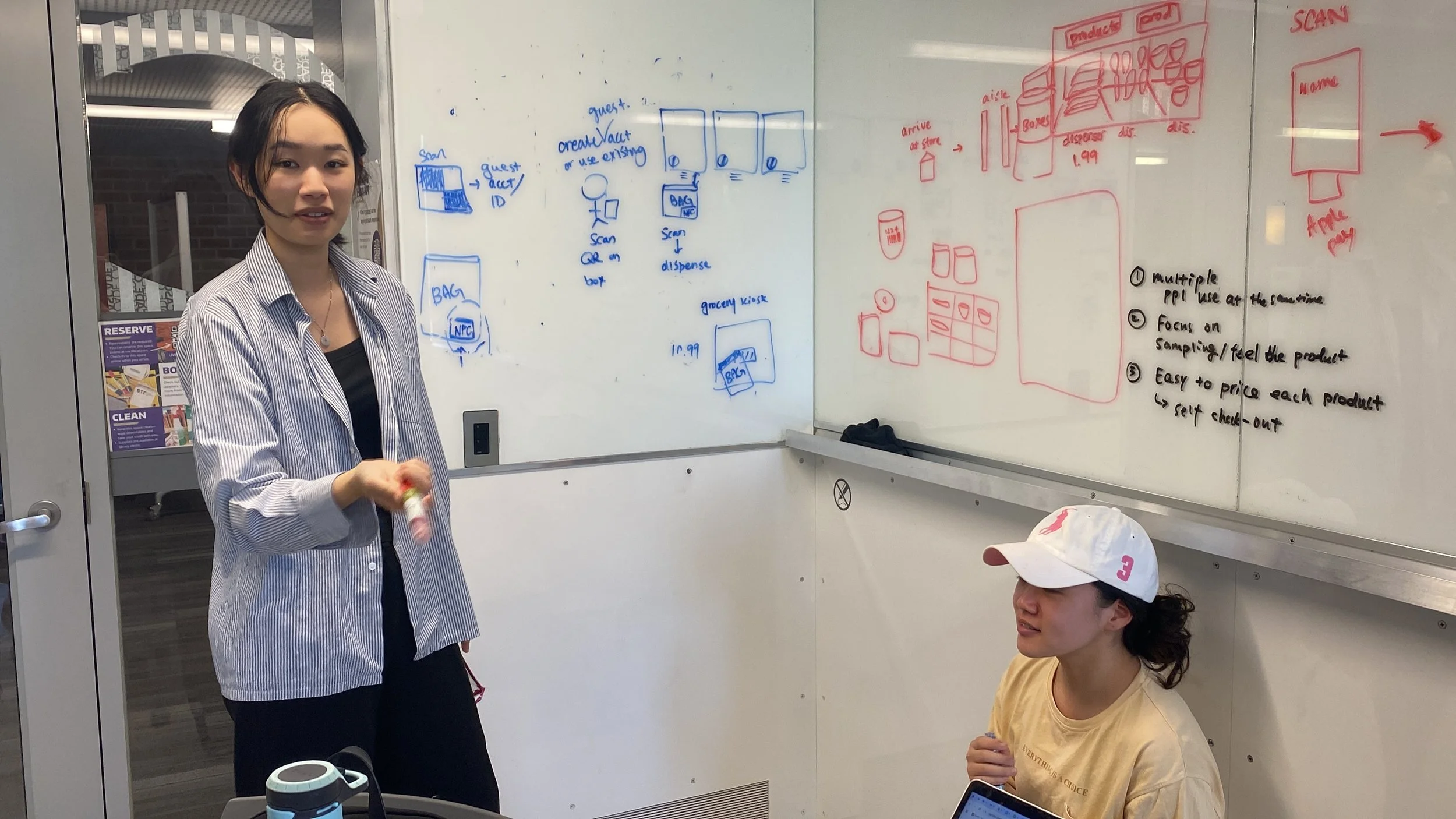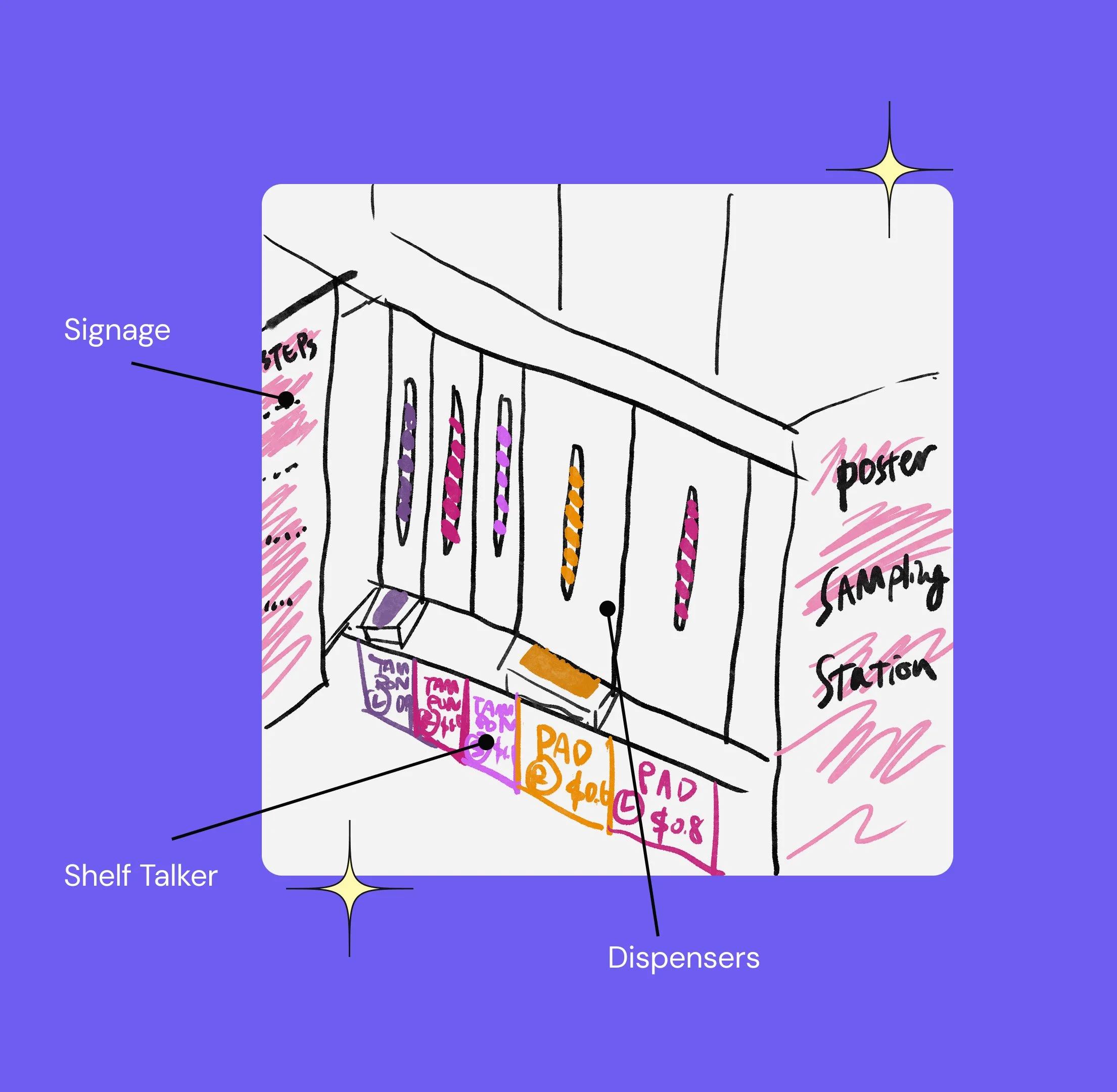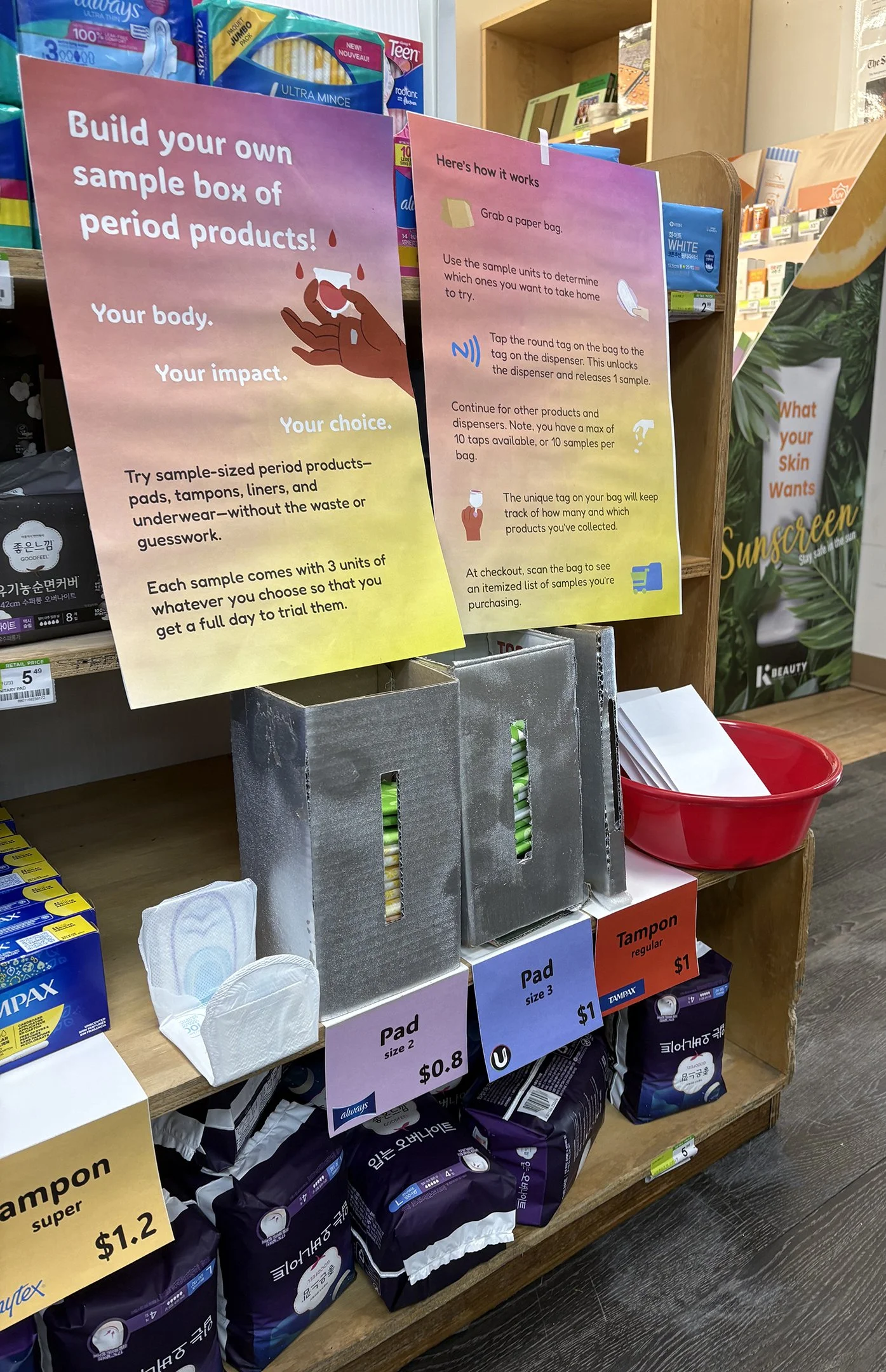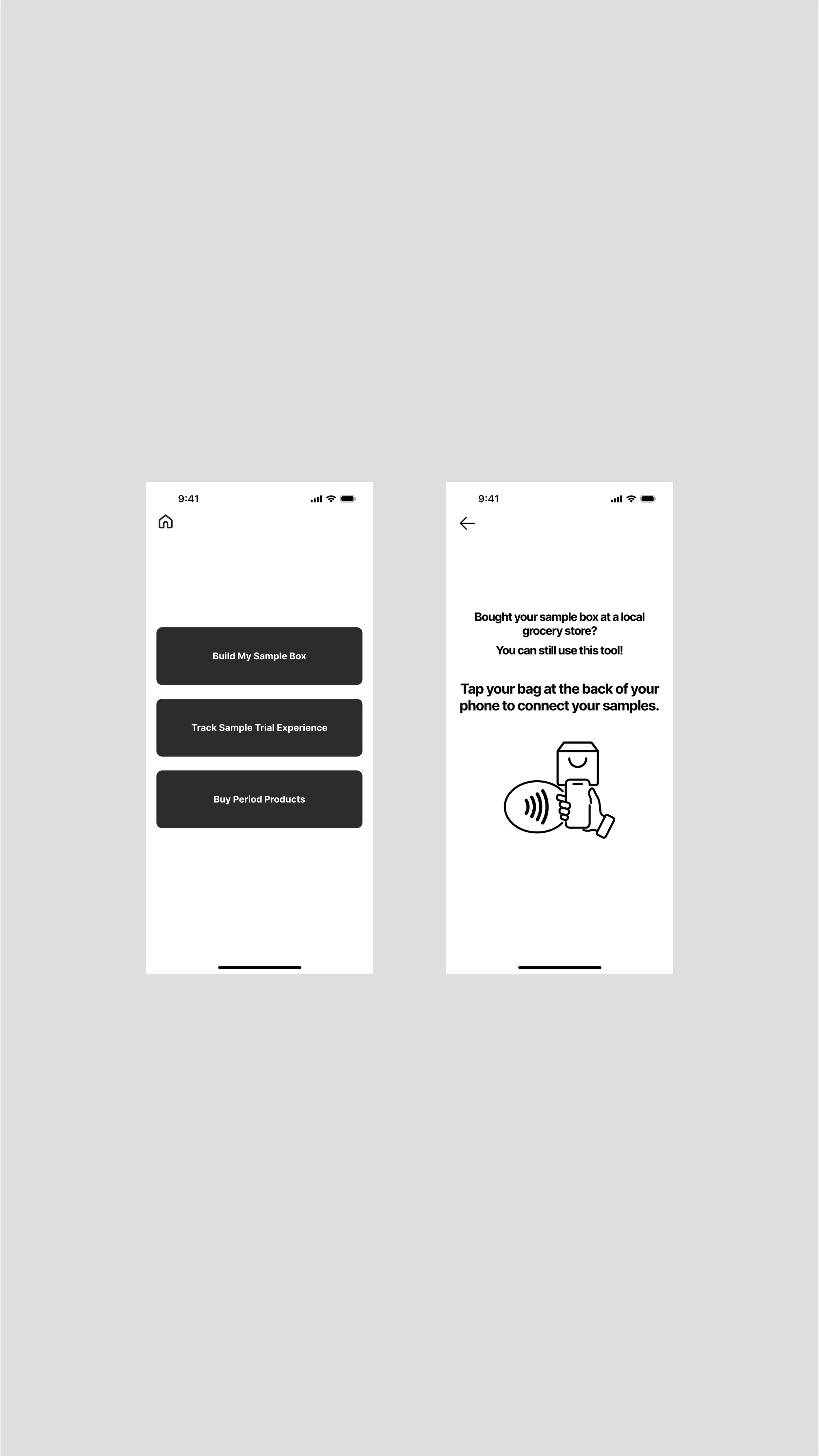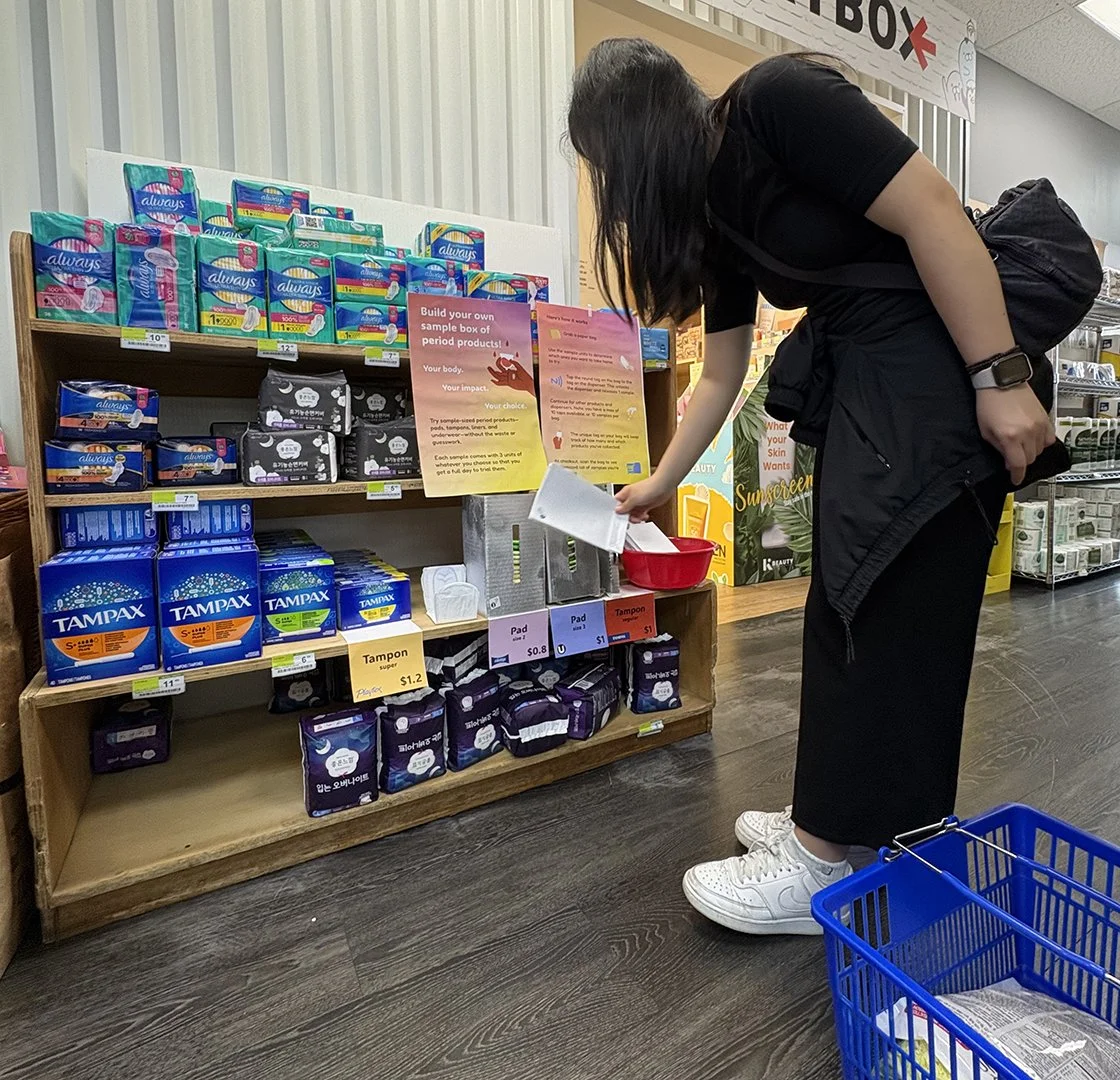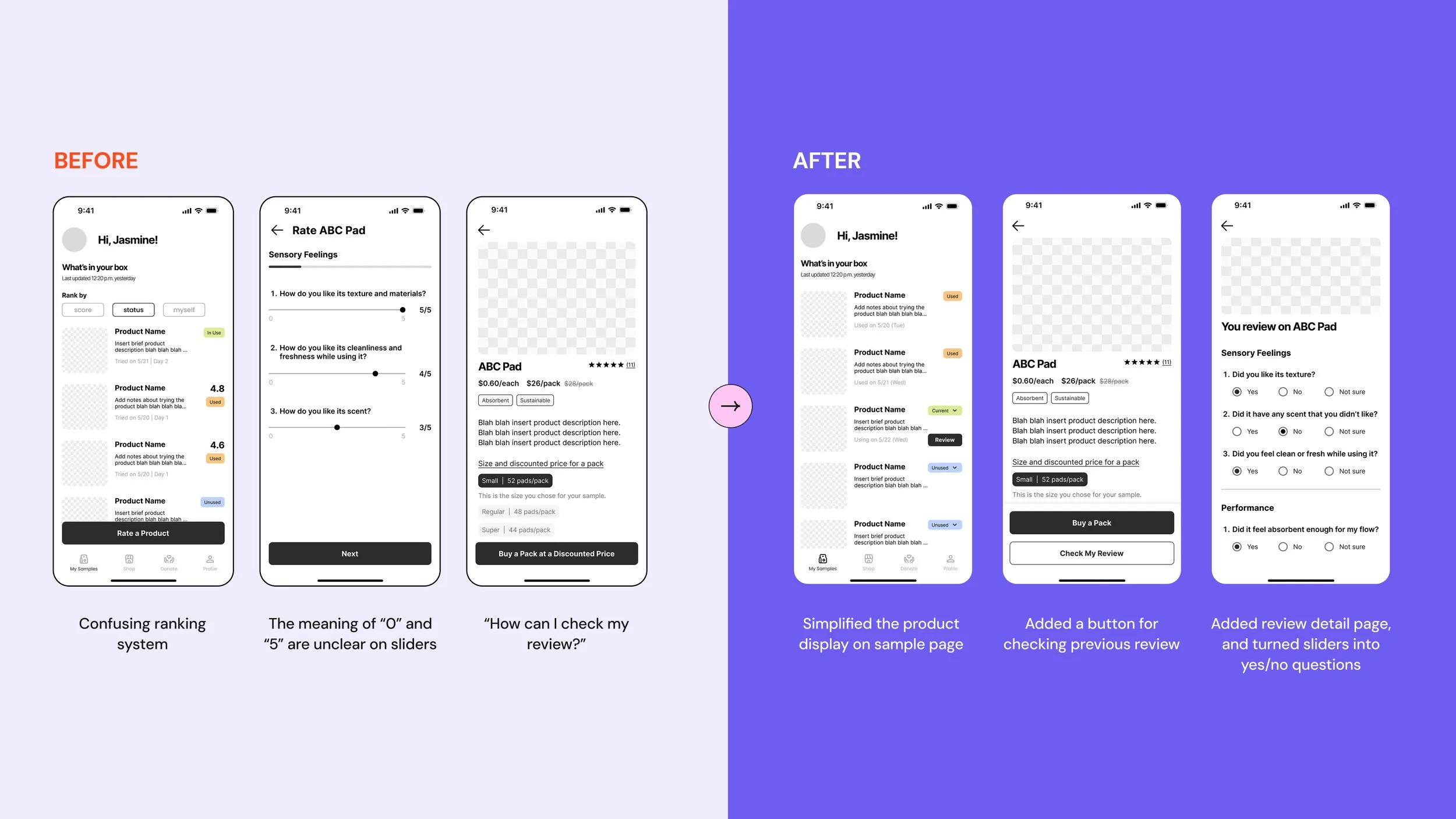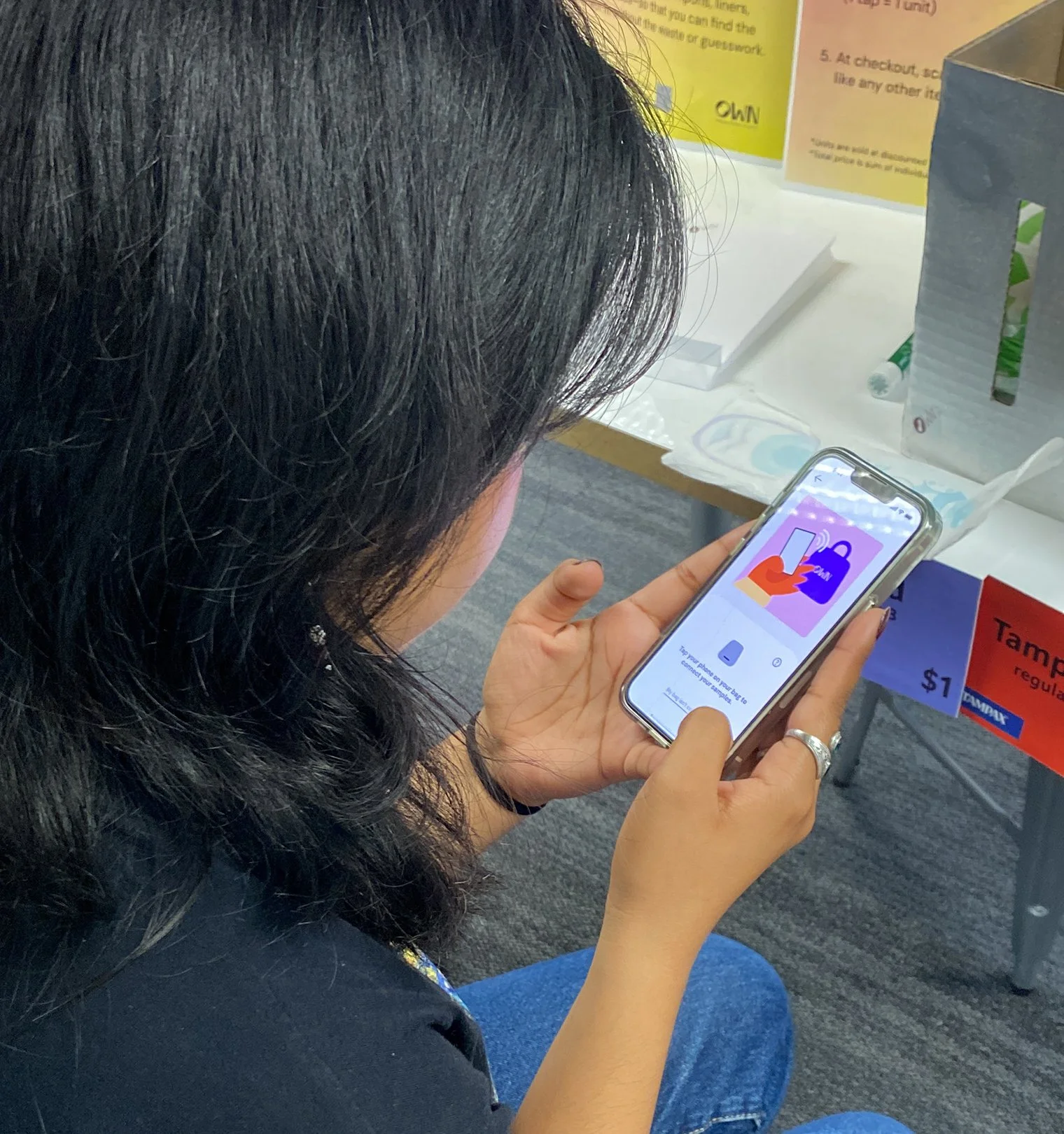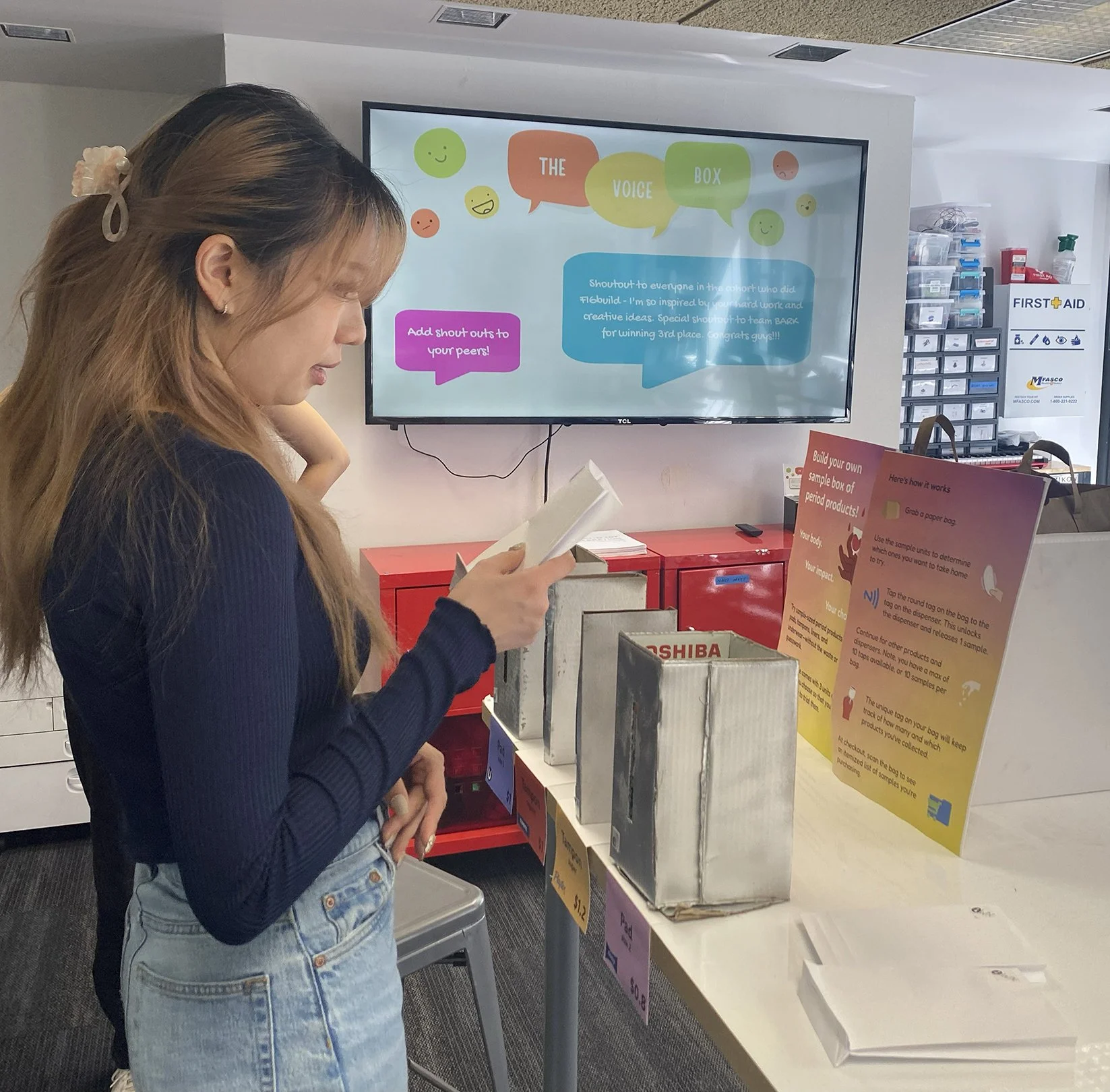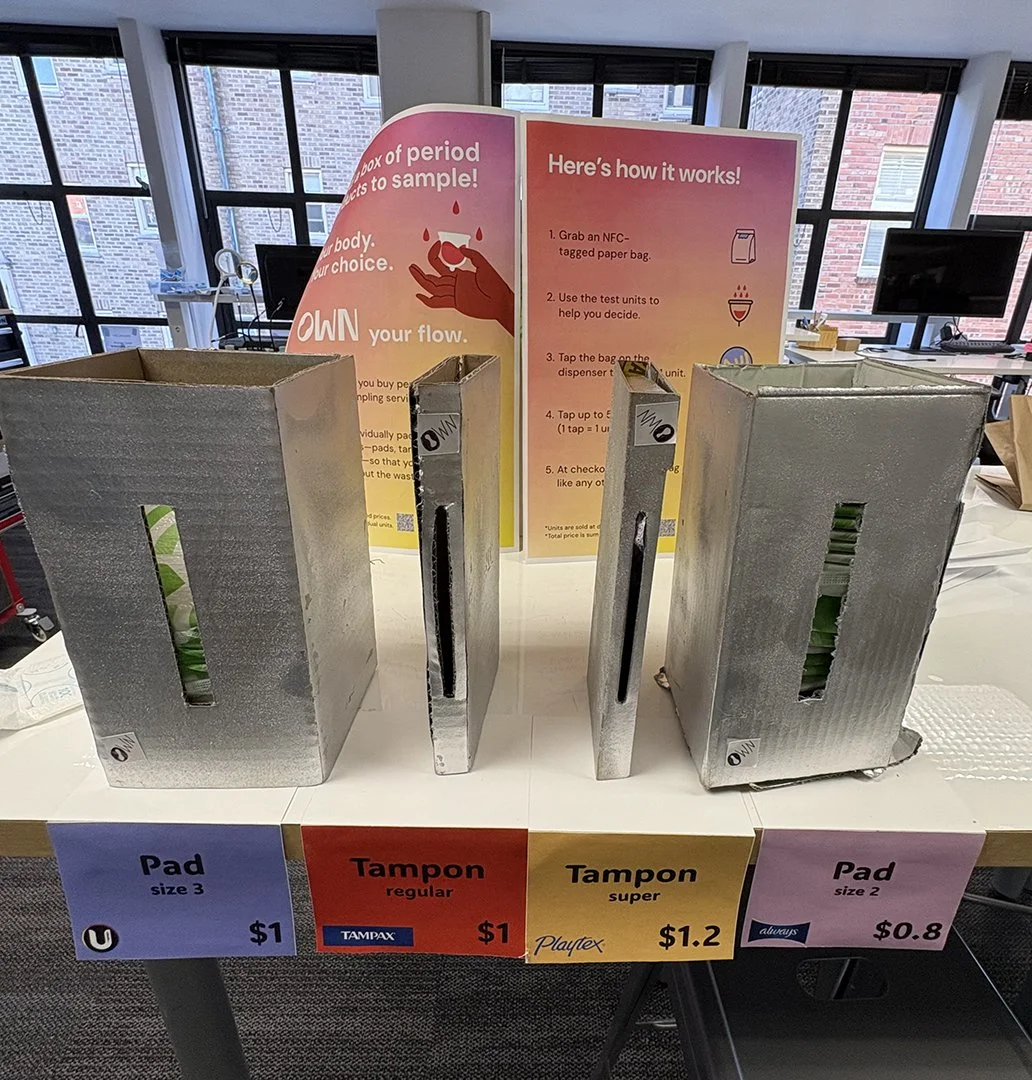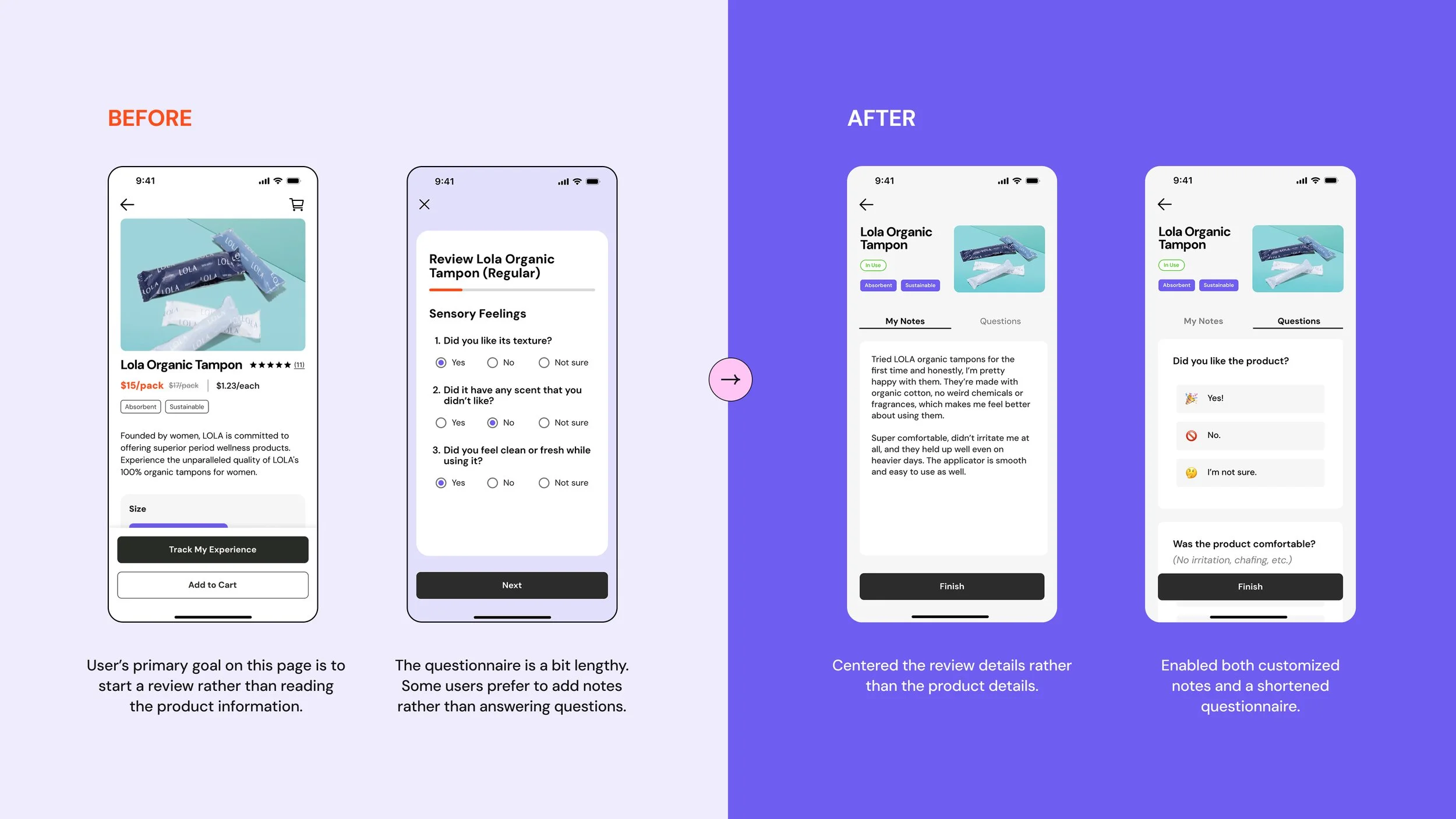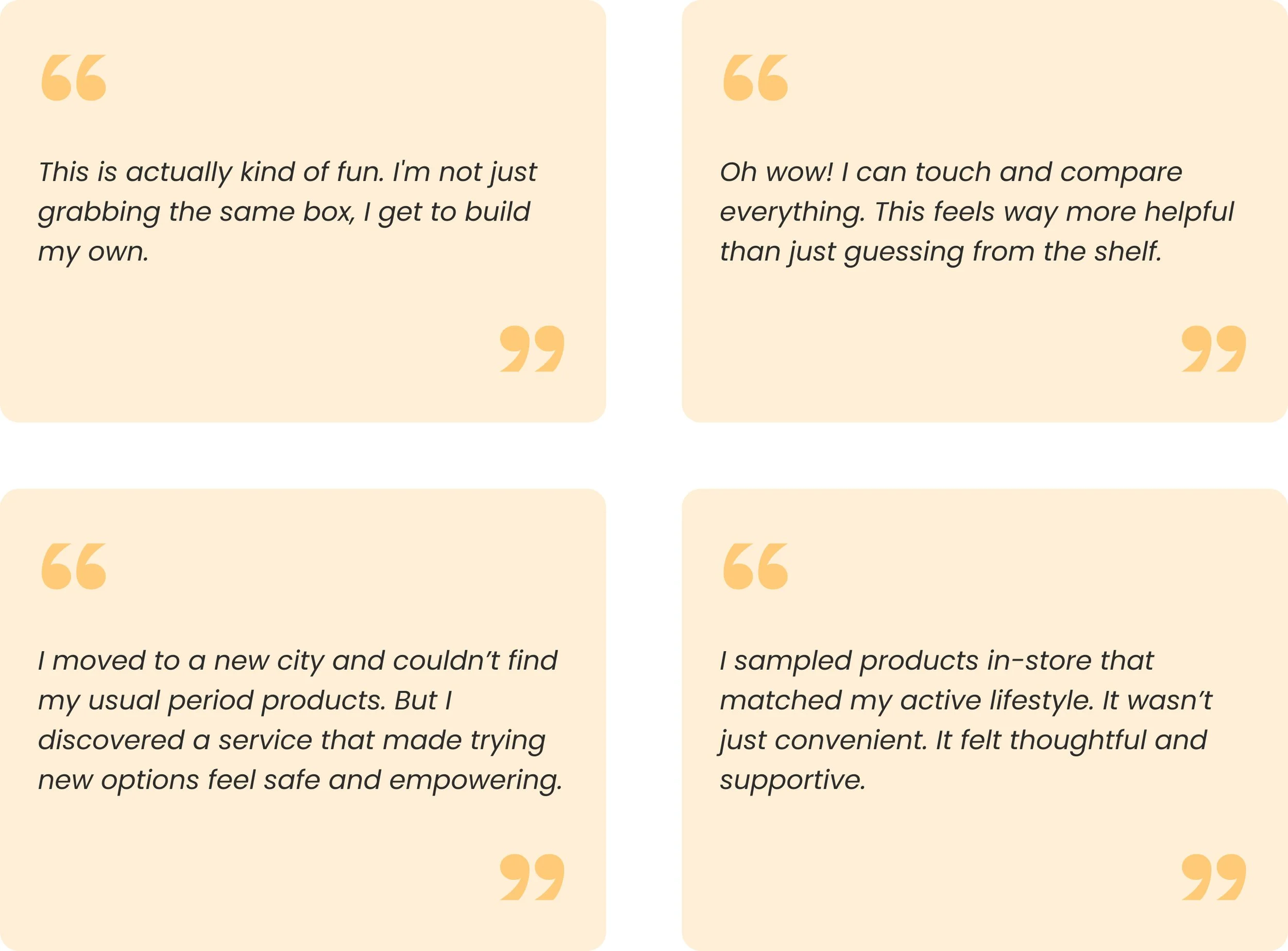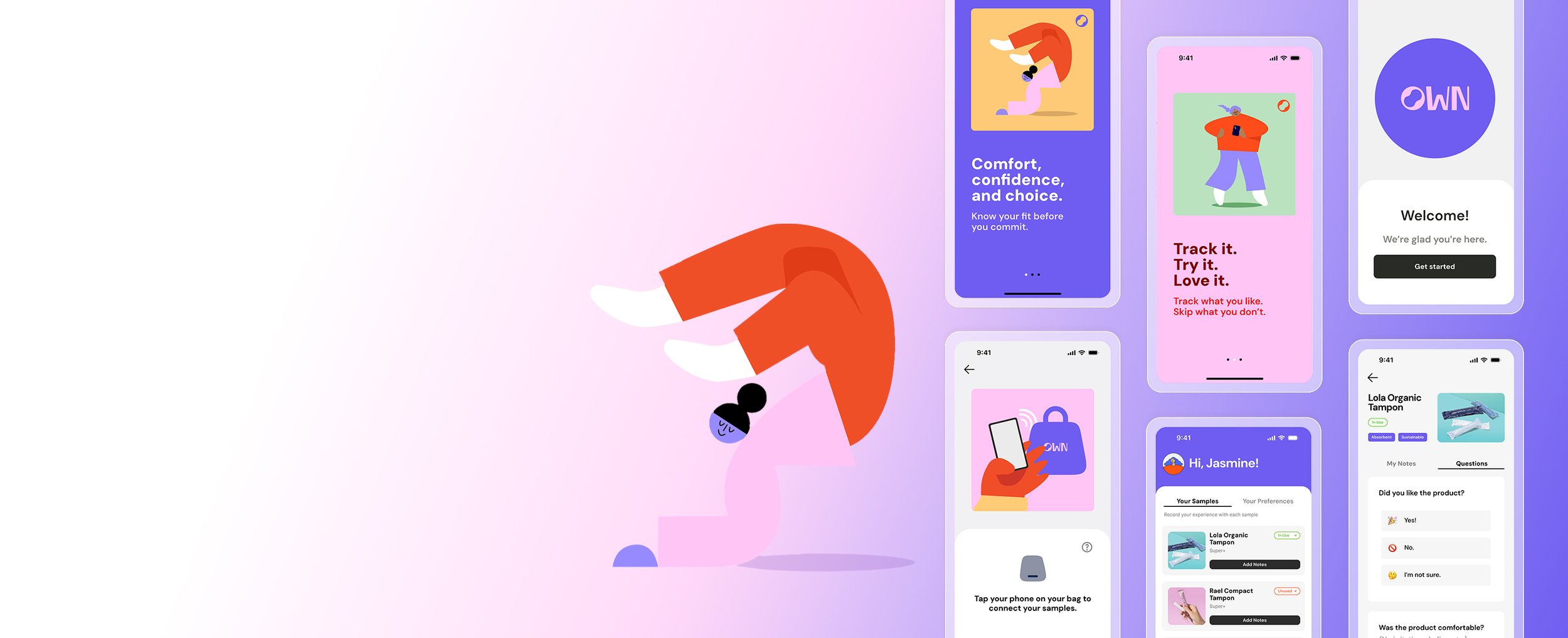
A sampling service redefining how we shop and use menstrual products
Project Type
School Project
My Role
Product Designer
Branding Designer
Video Producer
Timeline
May - Jun 2025
Team
Linda Xiao
Pearl Zhong
Elaine Park
Xinyi Zhao
Tools
Figma, After Effects, Final Cut Pro
OVERVIEW
After moving to Seattle, I couldn’t find my usual period product brand and ended up buying an uncomfortable alternative in bulk. This frustrating experience inspired me to build a period product sampling service that empowers menstruators with personalized choices in my Designing Information Experiences course at UW’s MHCI+D program.
The video below offers a quick overview of the project, which I planned, filmed, and edited myself!
DISCOVER THE PROBLEM
Big Packs, Big and Costly Mistake.
To uncover the root causes and significance of this issue and guide effective design decisions, we conducted secondary research to understand the broader context of period product challenges, complemented by primary research including a 38-response survey and 6 unstructured interviews.
RESEARCH
According to our research data, we found that period products are:
*National Organization for Women
With the research data on hand, I composited a storyboard following menstruators’ emotional journey and their pain points when buying a new period product, including a sense of overwhelming decision paralysis, uncertainty about the money spent, and disappointment.
PROBLEM STORYBOARD
The feedback from users inspired us to work on a sampling program to address the problem.
POTENTIAL SOLUTIONS
INITIAL DESIGN CONCEPT
What if purchasing period products was like buying makeup?
To uncover opportunities for improving the experience of buying new period products, we created a customer journey map to visualize pain points and emotions throughout the process. We found that the most friction occurred at two key stages: product selection at the point of purchase and realizing the product was unsuitable after first use.
SOLUTION STORYBOARD
Then, I visualized the reimagined experience by drawing a storyboard with our potential solutions: offering a sampling service together with sample trial tracking for comparison to help menstruators make the decision for longer use.

Curate Your Style
Beyond offering the simple sampling service, we hope to build a meaningful experience that empowers menstruators with ease of choice, autonomy, and self-expression.
These are the values we create with our service and product:
With these values, we imagine our customers to ultimately become:
These brand values also became our design principles that guide our later design decision-making. With these aspirations, we named our service “Own”, meaning “own your flow” and the autonomy customers have when choosing their personalized menstrual products.
CRAFT DESIGN SOLUTIONS
Next, we drafted the high-level structure of our design through bodystorming, sketching, and user flow.
Our proposed solution featured two integrated parts: a physical in-store retail experience and a digital sample tracking experience. Customers would visit the “Own” section in local drug or grocery stores to select and purchase their preferred period product samples, then use the mobile app to log and compare their trial experiences.
LOW-FIDELITY PROTOTYPES
We built low-fidelity prototypes for both physical and digital experiences to quickly visualize our design concept.
When customers enter the “Own” section at a local drugstore or grocery store, clear signage guides them through creating their own sample bag, while shelf talkers provide helpful information on product types and prices.
Customers start by picking up an empty sample bag and exploring products through touch and feel. To ensure hygiene and safety, I designed an efficient, contact-minimized sample dispensing flow: users tap the NFC tag on their bag against a dispenser’s reader to select samples. At checkout, the bag’s barcode, linked to a database, automatically displays the selected items and total cost.
Physical In-Store Retail Experience
Digital Sample Tracking Experience
I led the design of the digital prototype, focusing on the sample trial tracking experience. Users can link their samples by scanning the NFC tag on their bag with their mobile device, then mark each sample as “in use” or “used.” After completing a trial, they record their experience through a short reflective questionnaire, enabling easy comparison across different products.
CONCEPT EVALUATION & DESIGN ITERATIONS
To assess whether our design concept met customer expectations and addressed the challenge of buying menstrual products without knowing if they would suit their needs, we conducted an initial round of concept testing using low-fidelity prototypes.
We tested our in-store retail prototype at a local grocery store with two participants. While they found the concept effective, they struggled with instructions and pricing due to dense text. We responded by simplifying signage and clarifying the pricing model.
In-Store Retail: Evaluation & Iteration I
For the digital tracking experience, I tested the primary sample trial flow with two participants. They found the solution effective for selecting products that suited their personal needs, but experienced some confusion along the way. I then refined the design based on their feedback. Below are examples of the iterations.
Digital Tracking: Evaluation & Iteration I
In-Store Retail + Digital Tracking: Evaluation II
Next, I developed a mid-fidelity version of the sample trial tracking flow, complementing the onboarding flow created by my teammate. We then tested the end-to-end experience with three participants to evaluate user flows and usability before moving to high-fidelity prototypes. While feedback was generally positive, the second round of testing revealed areas for further improvement.
In-Store Retail: Iteration II
To reduce confusion in the in-store experience, we simplified signage by replacing jargon (e.g., using “samples” instead of “test units”), added product type details to highlight features like daily, active, or sport use, and included QR codes on both signage and sample bags to guide users to the mobile app, seamlessly connecting the physical and digital experiences.
BEFORE
AFTER
Digital Tracking: Iteration II
Participants’ main concerns focused on the complex information on the initial sample review page, the lack of an overview of all tracked items, and the length and format of the questionnaire. I collaborated with the team to align on directions for design refinements.
Finally, we added more interaction details to build the high-fidelity prototype, where I focused on interactions, transitions, and motion design.
FINAL DIGITAL DESIGN
HIGH FIDELITY PROTOTYPE
The samples can be linked to the mobile app by simply tapping the NFC tag on the sample bag to the device.
On Boarding
Sample statuses are marked “unused” by default and can be changed to “in use” or “used”.
Track Sample Status
The user can add their feelings and thoughts on a sample through writing notes or answering 5 preset questions.
Review Trial Experience
The system will generate the user’s product preferences by analyzing their feedback on the samples. The user can take the suggestions as a reference when deciding which products to buy in full packs.
Product Suggestions
I led the branding design for our brand, Own. To reflect the stylish, feminine aesthetic of our target audience while conveying playfulness, freedom, and autonomy, I developed a color palette that embodies these qualities. I also modified the circular “O” in the logo to resemble a pad, subtly reinforcing the brand’s connection to menstrual products.
BRANDING
I also prioritized accessibility in the branding design. Initially, I selected #978AFF as the primary purple, but testing against WCAG 2.1 AA contrast standards revealed it was insufficient. I then adjusted it to a darker, more saturated #6E5DF1 to ensure better visibility and compliance.
OUTCOME
User testing revealed positive feedback affirming the effectiveness and value of Own. The in-store sample bag-building experience created meaningful interactions through embodiment, attention, and emotional connection, while the overall value of the solution was reinforced by the delightful experiences participants recalled after using it.
We addressed business viability by exploring online sample bag ordering and offering full-pack discounts for sample users. Sustainability was also a focus, leading us to prototype a donation flow for unused products. Low-fidelity prototypes for these features informed our scope, with plans to continue refining both offline and digital experiences.
Our main challenge was user retention. While menstruators aged 20–35 are open to trying new products, they may not return once they find a fit. To address this, we considered pivoting to teenagers and first-time menstruators, who benefit from product education, positioning the service as a learning tool for future design iterations.
NEXT STEPS & REFLECTIONS
E-commerce mini-app for lifestyle products
Conversational AI dietitian for health management


